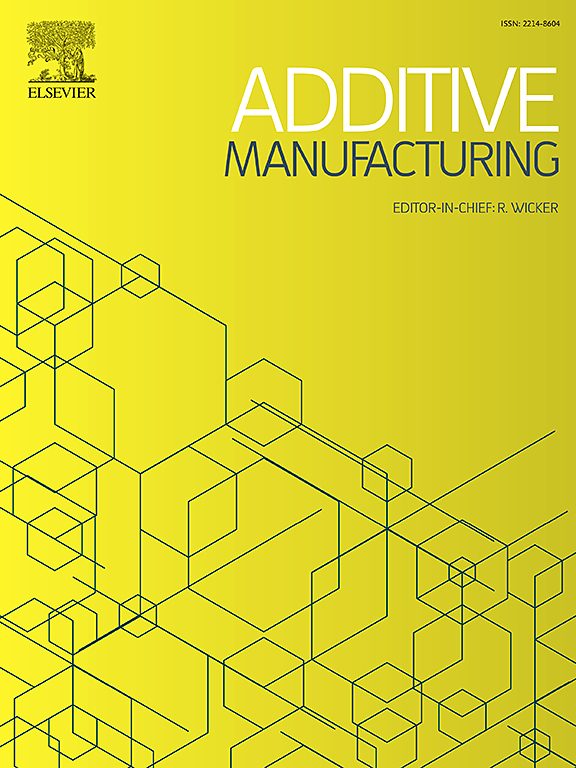激光定向能沉积精确逆工艺优化框架
IF 10.3
1区 工程技术
Q1 ENGINEERING, MANUFACTURING
引用次数: 0
摘要
在增材制造(AM)领域,尤其是基于激光的金属增材制造领域,工艺优化对产品质量和生产效率至关重要。然而,从广阔的参数空间中确定最佳工艺参数是一项艰巨的任务。尽管模拟技术不断进步,但针对特定材料和几何形状的工艺优化仍是通过一种连续、耗时的试错方法进行的,而且往往缺乏解决多重优化目标的多功能性。机器学习(ML)为加速优化过程提供了强大的工具,但目前的大多数研究都集中在简单的单轨打印上,很难转化为工程应用中的三维散件制造。在本研究中,我们基于机器学习模型和遗传算法,开发了激光定向能沉积(AIDED)中的精确逆过程优化框架,以帮助激光 DED 中的过程优化。利用 AIDED,我们证明了以下几点:(i) 准确预测了单轨熔池的面积(R2 得分为 0.995)、多轨熔池的倾斜角度(R2 得分为 0.969)和多层熔池的横截面几何形状(宽度和高度误差分别为 1.75 % 和 12.(ii) 确定适当的舱口间距和层厚度,以制造完全致密(密度为 99.9%)的多轨道和多层印刷品;(iii) 在 1-3 小时内直接根据可定制的应用目标反向确定最佳工艺参数。我们还通过解决多目标优化问题验证了 AIDED 的有效性,该问题旨在确定最佳工艺参数,从而以较小的有效轨宽实现较高的印刷速度。此外,我们还利用少量有关纯镍的额外数据,展示了该框架从不锈钢到纯镍的可移植性。有了 AIDED 的这种可移植性,我们为 "辅助 "适用于各种材料的基于激光的 AM 过程优化铺平了一条新路。本文章由计算机程序翻译,如有差异,请以英文原文为准。
Accurate inverse process optimization framework in laser directed energy deposition
In additive manufacturing (AM), particularly in laser-based metal AM, process optimization is crucial to the quality of products and the efficiency of production. The identification of optimal process parameters out of a vast parameter space, however, is a daunting task. Despite advances in simulations, the process optimization for specific materials and geometries is developed through a sequential and time-consuming trial-and-error approach and often lacks the versatility to address multiple optimization objectives. Machine learning (ML) provides a powerful tool to accelerate the optimization process, but most current studies focus on simple single-track prints, which hardly translate to manufacturing 3D bulk components for engineering applications. In this study, we develop an Accurate Inverse process optimization framework in laser Directed Energy Deposition (AIDED), based on machine learning models and a genetic algorithm, to aid the process optimization in laser DED. Using AIDED, we demonstrate the following: (i) Accurate prediction of the area of single-track melt pool (R2 score 0.995), the tilt angle of multi-track melt pool (R2 score 0.969), and the cross-sectional geometries of multi-layer melt pool (1.75 % and 12.04 % errors in width and height, respectively) directly from process parameters; (ii) Determination of appropriate hatch spacing and layer thickness for fabricating fully dense (density > 99.9 %) multi-track and multi-layer prints; (iii) Inverse identification of optimal process parameters directly from customizable application objectives within 1–3 hours. We also validate the effectiveness of the AIDED experimentally by solving a multi-objective optimization problem to identify the optimal process parameters for achieving high print speeds with small effective track widths. Furthermore, we show the transferability of the framework from stainless steel to pure nickel using a small amount of additional data on pure nickel. With such transferability in AIDED, we pave a new way for “aiding” the process optimization of the laser-based AM processes that applies to a wide range of materials.
求助全文
通过发布文献求助,成功后即可免费获取论文全文。
去求助
来源期刊

Additive manufacturing
Materials Science-General Materials Science
CiteScore
19.80
自引率
12.70%
发文量
648
审稿时长
35 days
期刊介绍:
Additive Manufacturing stands as a peer-reviewed journal dedicated to delivering high-quality research papers and reviews in the field of additive manufacturing, serving both academia and industry leaders. The journal's objective is to recognize the innovative essence of additive manufacturing and its diverse applications, providing a comprehensive overview of current developments and future prospects.
The transformative potential of additive manufacturing technologies in product design and manufacturing is poised to disrupt traditional approaches. In response to this paradigm shift, a distinctive and comprehensive publication outlet was essential. Additive Manufacturing fulfills this need, offering a platform for engineers, materials scientists, and practitioners across academia and various industries to document and share innovations in these evolving technologies.
 求助内容:
求助内容: 应助结果提醒方式:
应助结果提醒方式:


